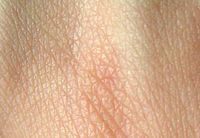
Photo from wikipedia
BACKGROUND Skin aging manifestation, such as coarse wrinkles, loss of elasticity, pigmentation, and rough-textured appearance, is a multifactorial process that can be exacerbated by air pollution, smoking, poor nutrition, and… Click to show full abstract
BACKGROUND Skin aging manifestation, such as coarse wrinkles, loss of elasticity, pigmentation, and rough-textured appearance, is a multifactorial process that can be exacerbated by air pollution, smoking, poor nutrition, and sun exposure. Exposure to UV radiation is considered the primary cause of extrinsic skin aging and accounts for about 80% of facial aging. Extrinsic skin aging signs can be reduced with demo-cosmetic formulations. Both cannabidiol (CBD) and eicosapentaenoic acid (EPA) have been previously suggested as potent active dermatological ingredients. AIMS The objective of the current research was to evaluate the compatibility of both agents in the prevention and treatment of skin aging. First, the impact of both agents was assessed using standard photoaging models of UV-induced damage, both in vitro (HaCaT cells) and ex vivo (human skin organ culture). Then, a clinical validation study (n = 33) was performed using an optimized topical cream formulation tested at different time points (up to Day 56). RESULTS EPA was found to potentiate the protective effects of CBD by reducing the secretion of prostaglandin E2 (PGE2 ) and interleukin-8 (IL-8), two primary inflammatory agents associated with photoaging. In addition, a qualitative histological examination signaled that applying the cream may result in an increase in extracellular matrix (ECM) remodeling following UV radiation. This was also evidenced clinically by a reduction of crow's feet wrinkle area and volume, as well as a reduction of fine line wrinkle volume as measured by the AEVA system. The well-established age-dependent subepidermal low-echogenic band (SLEB) was also reduced by 8.8%. Additional clinical results showed significantly reduced red spots area and count, and an increase in skin hydration and elasticity by 31.2% and 25.6% following 56 days of cream application, respectively. These impressive clinical results correlated with high satisfaction ratings by the study participants. DISCUSSION AND CONCLUSIONS Collectively, the results show a profound anti-aging impact of the developed formulation and strengthen the beneficial derm-cosmetic properties of CBD-based products.
Journal Title: Journal of cosmetic dermatology
Year Published: 2023
Link to full text (if available)
Share on Social Media: Sign Up to like & get
recommendations!